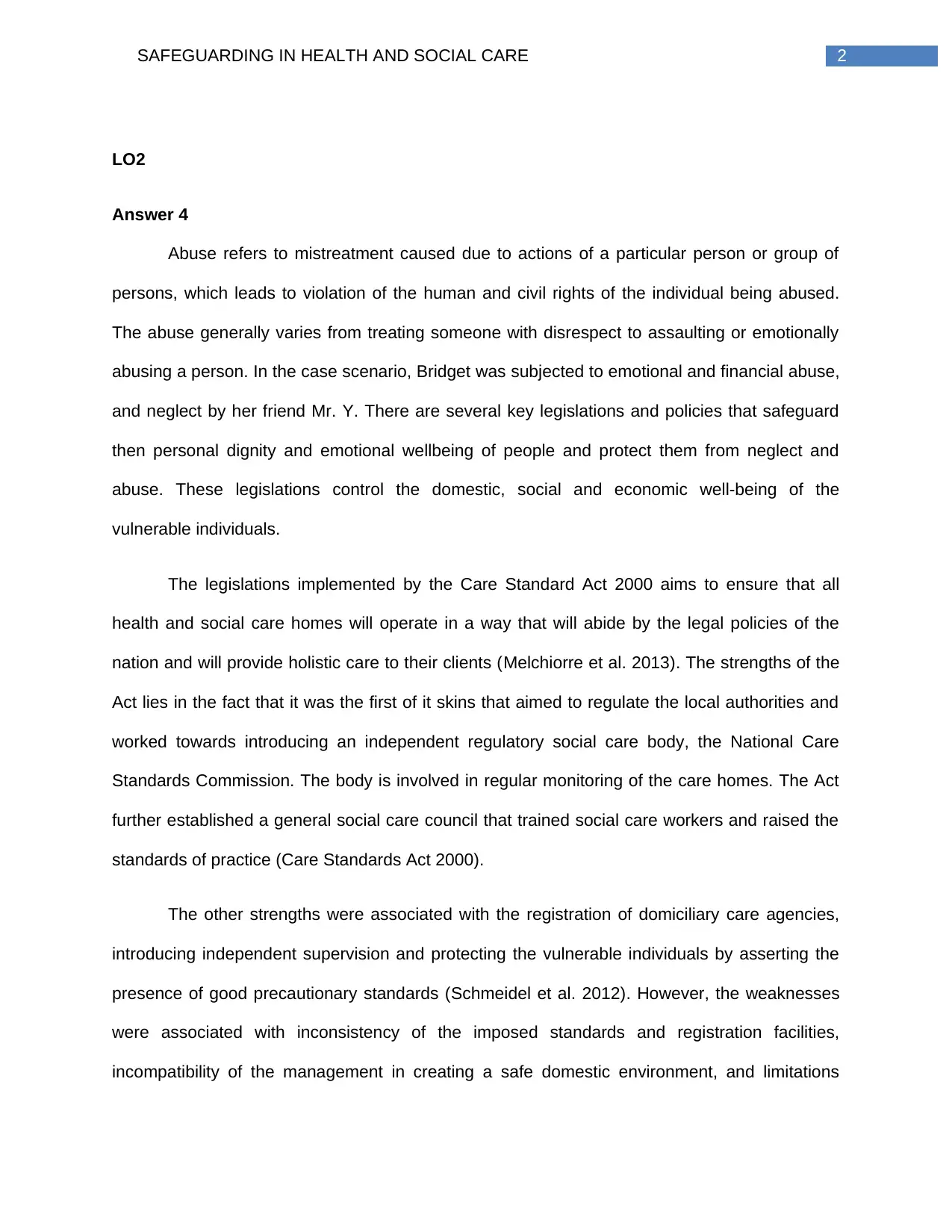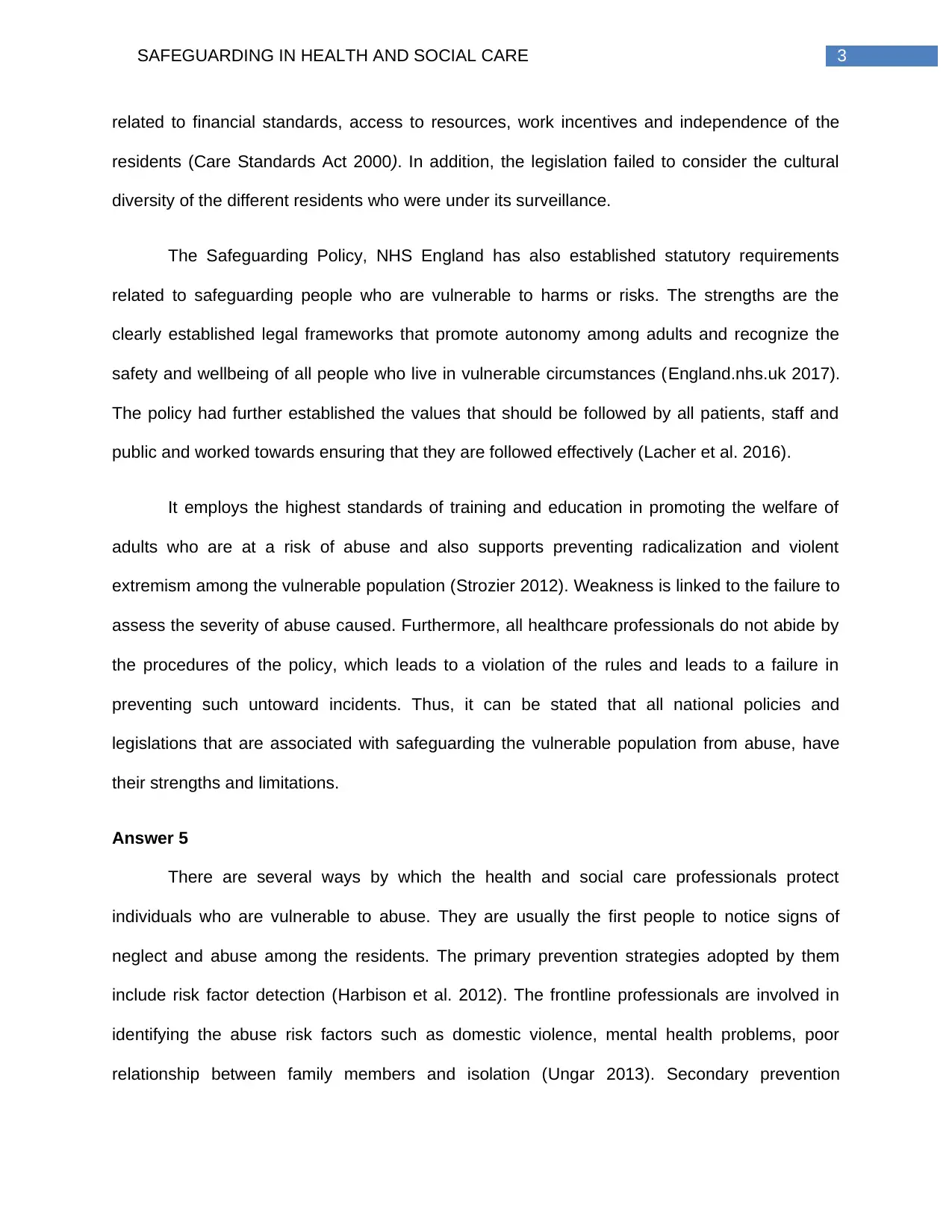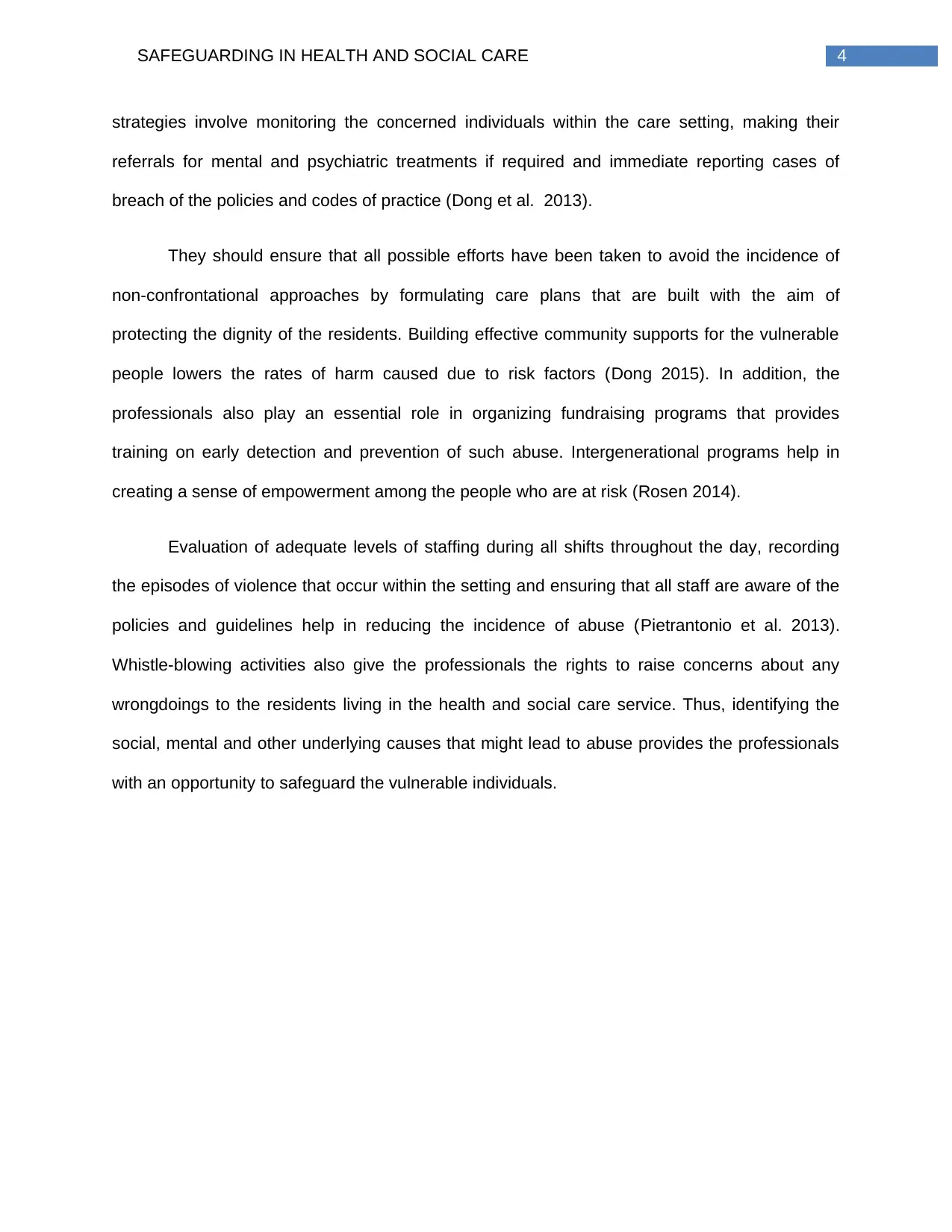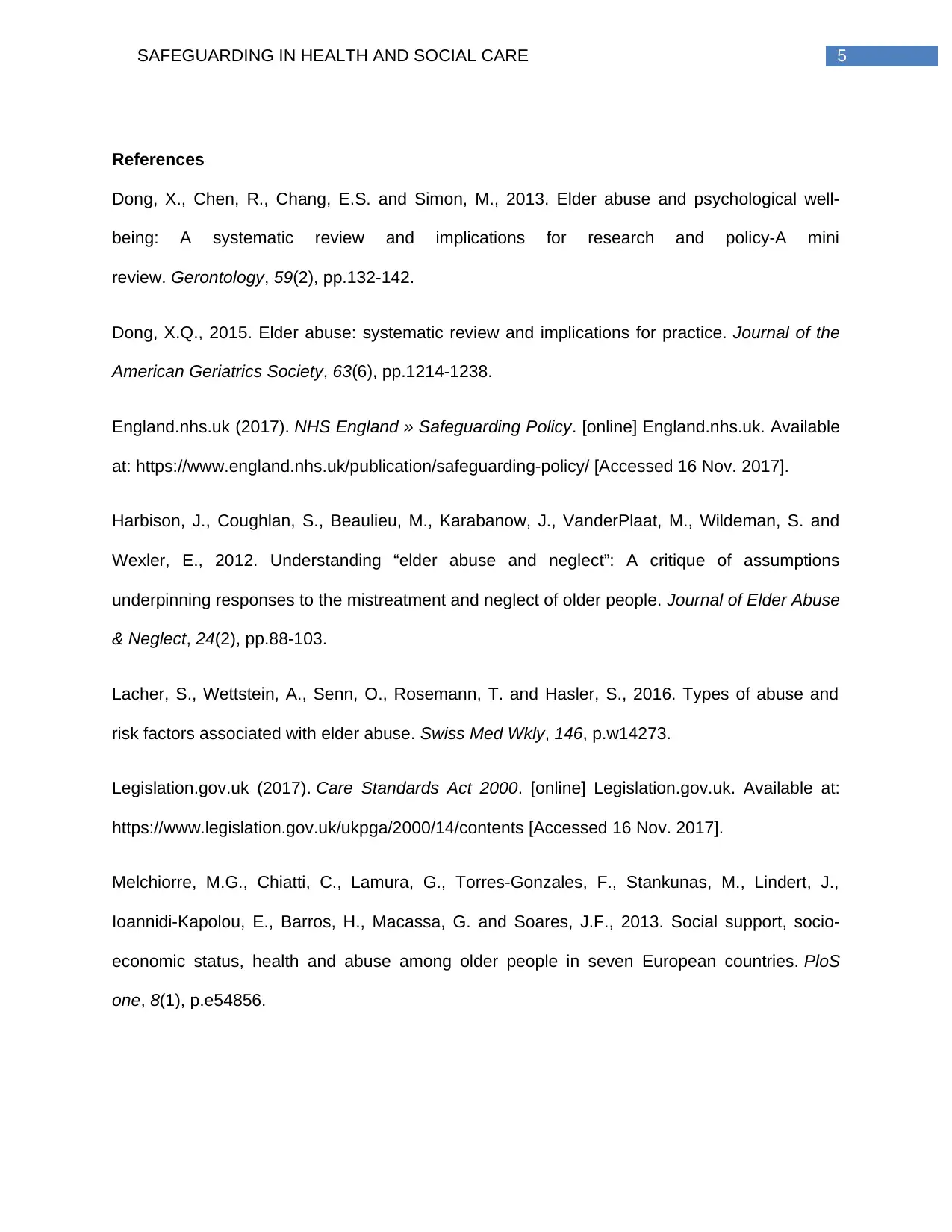Promoting Safeguarding Practices in Health and Social Care Report
VerifiedAdded on 2020/04/21
|7
|1461
|89
Report
AI Summary
This report focuses on safeguarding practices within the health and social care sector, examining key legislations such as the Care Standards Act 2000 and the NHS England Safeguarding Policy. It explores the strengths and weaknesses of these policies in protecting vulnerable individuals from abuse, neglect, and emotional and financial exploitation, as illustrated by a case scenario involving emotional and financial abuse. The report further details the roles of healthcare professionals in preventing abuse, including risk factor detection, monitoring, reporting, and community support strategies. It emphasizes the importance of early detection, intergenerational programs, and adequate staffing in safeguarding vulnerable populations. The report references relevant literature to support its findings, highlighting the multifaceted nature of safeguarding in health and social care and the ongoing efforts to improve protective measures.

Running head: SAFEGUARDING IN HEALTH AND SOCIAL CARE
Case scenario- Promoting good practice of safeguarding in health and social care
Name of the Student
Name of the University
Author Note
Case scenario- Promoting good practice of safeguarding in health and social care
Name of the Student
Name of the University
Author Note
Paraphrase This Document
Need a fresh take? Get an instant paraphrase of this document with our AI Paraphraser

1SAFEGUARDING IN HEALTH AND SOCIAL CARE
Table of Contents
LO2................................................................................................................................................2
Answer 4....................................................................................................................................2
Answer 5....................................................................................................................................3
References....................................................................................................................................5
Table of Contents
LO2................................................................................................................................................2
Answer 4....................................................................................................................................2
Answer 5....................................................................................................................................3
References....................................................................................................................................5

2SAFEGUARDING IN HEALTH AND SOCIAL CARE
LO2
Answer 4
Abuse refers to mistreatment caused due to actions of a particular person or group of
persons, which leads to violation of the human and civil rights of the individual being abused.
The abuse generally varies from treating someone with disrespect to assaulting or emotionally
abusing a person. In the case scenario, Bridget was subjected to emotional and financial abuse,
and neglect by her friend Mr. Y. There are several key legislations and policies that safeguard
then personal dignity and emotional wellbeing of people and protect them from neglect and
abuse. These legislations control the domestic, social and economic well-being of the
vulnerable individuals.
The legislations implemented by the Care Standard Act 2000 aims to ensure that all
health and social care homes will operate in a way that will abide by the legal policies of the
nation and will provide holistic care to their clients (Melchiorre et al. 2013). The strengths of the
Act lies in the fact that it was the first of it skins that aimed to regulate the local authorities and
worked towards introducing an independent regulatory social care body, the National Care
Standards Commission. The body is involved in regular monitoring of the care homes. The Act
further established a general social care council that trained social care workers and raised the
standards of practice (Care Standards Act 2000).
The other strengths were associated with the registration of domiciliary care agencies,
introducing independent supervision and protecting the vulnerable individuals by asserting the
presence of good precautionary standards (Schmeidel et al. 2012). However, the weaknesses
were associated with inconsistency of the imposed standards and registration facilities,
incompatibility of the management in creating a safe domestic environment, and limitations
LO2
Answer 4
Abuse refers to mistreatment caused due to actions of a particular person or group of
persons, which leads to violation of the human and civil rights of the individual being abused.
The abuse generally varies from treating someone with disrespect to assaulting or emotionally
abusing a person. In the case scenario, Bridget was subjected to emotional and financial abuse,
and neglect by her friend Mr. Y. There are several key legislations and policies that safeguard
then personal dignity and emotional wellbeing of people and protect them from neglect and
abuse. These legislations control the domestic, social and economic well-being of the
vulnerable individuals.
The legislations implemented by the Care Standard Act 2000 aims to ensure that all
health and social care homes will operate in a way that will abide by the legal policies of the
nation and will provide holistic care to their clients (Melchiorre et al. 2013). The strengths of the
Act lies in the fact that it was the first of it skins that aimed to regulate the local authorities and
worked towards introducing an independent regulatory social care body, the National Care
Standards Commission. The body is involved in regular monitoring of the care homes. The Act
further established a general social care council that trained social care workers and raised the
standards of practice (Care Standards Act 2000).
The other strengths were associated with the registration of domiciliary care agencies,
introducing independent supervision and protecting the vulnerable individuals by asserting the
presence of good precautionary standards (Schmeidel et al. 2012). However, the weaknesses
were associated with inconsistency of the imposed standards and registration facilities,
incompatibility of the management in creating a safe domestic environment, and limitations
⊘ This is a preview!⊘
Do you want full access?
Subscribe today to unlock all pages.

Trusted by 1+ million students worldwide

3SAFEGUARDING IN HEALTH AND SOCIAL CARE
related to financial standards, access to resources, work incentives and independence of the
residents (Care Standards Act 2000). In addition, the legislation failed to consider the cultural
diversity of the different residents who were under its surveillance.
The Safeguarding Policy, NHS England has also established statutory requirements
related to safeguarding people who are vulnerable to harms or risks. The strengths are the
clearly established legal frameworks that promote autonomy among adults and recognize the
safety and wellbeing of all people who live in vulnerable circumstances (England.nhs.uk 2017).
The policy had further established the values that should be followed by all patients, staff and
public and worked towards ensuring that they are followed effectively (Lacher et al. 2016).
It employs the highest standards of training and education in promoting the welfare of
adults who are at a risk of abuse and also supports preventing radicalization and violent
extremism among the vulnerable population (Strozier 2012). Weakness is linked to the failure to
assess the severity of abuse caused. Furthermore, all healthcare professionals do not abide by
the procedures of the policy, which leads to a violation of the rules and leads to a failure in
preventing such untoward incidents. Thus, it can be stated that all national policies and
legislations that are associated with safeguarding the vulnerable population from abuse, have
their strengths and limitations.
Answer 5
There are several ways by which the health and social care professionals protect
individuals who are vulnerable to abuse. They are usually the first people to notice signs of
neglect and abuse among the residents. The primary prevention strategies adopted by them
include risk factor detection (Harbison et al. 2012). The frontline professionals are involved in
identifying the abuse risk factors such as domestic violence, mental health problems, poor
relationship between family members and isolation (Ungar 2013). Secondary prevention
related to financial standards, access to resources, work incentives and independence of the
residents (Care Standards Act 2000). In addition, the legislation failed to consider the cultural
diversity of the different residents who were under its surveillance.
The Safeguarding Policy, NHS England has also established statutory requirements
related to safeguarding people who are vulnerable to harms or risks. The strengths are the
clearly established legal frameworks that promote autonomy among adults and recognize the
safety and wellbeing of all people who live in vulnerable circumstances (England.nhs.uk 2017).
The policy had further established the values that should be followed by all patients, staff and
public and worked towards ensuring that they are followed effectively (Lacher et al. 2016).
It employs the highest standards of training and education in promoting the welfare of
adults who are at a risk of abuse and also supports preventing radicalization and violent
extremism among the vulnerable population (Strozier 2012). Weakness is linked to the failure to
assess the severity of abuse caused. Furthermore, all healthcare professionals do not abide by
the procedures of the policy, which leads to a violation of the rules and leads to a failure in
preventing such untoward incidents. Thus, it can be stated that all national policies and
legislations that are associated with safeguarding the vulnerable population from abuse, have
their strengths and limitations.
Answer 5
There are several ways by which the health and social care professionals protect
individuals who are vulnerable to abuse. They are usually the first people to notice signs of
neglect and abuse among the residents. The primary prevention strategies adopted by them
include risk factor detection (Harbison et al. 2012). The frontline professionals are involved in
identifying the abuse risk factors such as domestic violence, mental health problems, poor
relationship between family members and isolation (Ungar 2013). Secondary prevention
Paraphrase This Document
Need a fresh take? Get an instant paraphrase of this document with our AI Paraphraser

4SAFEGUARDING IN HEALTH AND SOCIAL CARE
strategies involve monitoring the concerned individuals within the care setting, making their
referrals for mental and psychiatric treatments if required and immediate reporting cases of
breach of the policies and codes of practice (Dong et al. 2013).
They should ensure that all possible efforts have been taken to avoid the incidence of
non-confrontational approaches by formulating care plans that are built with the aim of
protecting the dignity of the residents. Building effective community supports for the vulnerable
people lowers the rates of harm caused due to risk factors (Dong 2015). In addition, the
professionals also play an essential role in organizing fundraising programs that provides
training on early detection and prevention of such abuse. Intergenerational programs help in
creating a sense of empowerment among the people who are at risk (Rosen 2014).
Evaluation of adequate levels of staffing during all shifts throughout the day, recording
the episodes of violence that occur within the setting and ensuring that all staff are aware of the
policies and guidelines help in reducing the incidence of abuse (Pietrantonio et al. 2013).
Whistle-blowing activities also give the professionals the rights to raise concerns about any
wrongdoings to the residents living in the health and social care service. Thus, identifying the
social, mental and other underlying causes that might lead to abuse provides the professionals
with an opportunity to safeguard the vulnerable individuals.
strategies involve monitoring the concerned individuals within the care setting, making their
referrals for mental and psychiatric treatments if required and immediate reporting cases of
breach of the policies and codes of practice (Dong et al. 2013).
They should ensure that all possible efforts have been taken to avoid the incidence of
non-confrontational approaches by formulating care plans that are built with the aim of
protecting the dignity of the residents. Building effective community supports for the vulnerable
people lowers the rates of harm caused due to risk factors (Dong 2015). In addition, the
professionals also play an essential role in organizing fundraising programs that provides
training on early detection and prevention of such abuse. Intergenerational programs help in
creating a sense of empowerment among the people who are at risk (Rosen 2014).
Evaluation of adequate levels of staffing during all shifts throughout the day, recording
the episodes of violence that occur within the setting and ensuring that all staff are aware of the
policies and guidelines help in reducing the incidence of abuse (Pietrantonio et al. 2013).
Whistle-blowing activities also give the professionals the rights to raise concerns about any
wrongdoings to the residents living in the health and social care service. Thus, identifying the
social, mental and other underlying causes that might lead to abuse provides the professionals
with an opportunity to safeguard the vulnerable individuals.

5SAFEGUARDING IN HEALTH AND SOCIAL CARE
References
Dong, X., Chen, R., Chang, E.S. and Simon, M., 2013. Elder abuse and psychological well-
being: A systematic review and implications for research and policy-A mini
review. Gerontology, 59(2), pp.132-142.
Dong, X.Q., 2015. Elder abuse: systematic review and implications for practice. Journal of the
American Geriatrics Society, 63(6), pp.1214-1238.
England.nhs.uk (2017). NHS England » Safeguarding Policy. [online] England.nhs.uk. Available
at: https://www.england.nhs.uk/publication/safeguarding-policy/ [Accessed 16 Nov. 2017].
Harbison, J., Coughlan, S., Beaulieu, M., Karabanow, J., VanderPlaat, M., Wildeman, S. and
Wexler, E., 2012. Understanding “elder abuse and neglect”: A critique of assumptions
underpinning responses to the mistreatment and neglect of older people. Journal of Elder Abuse
& Neglect, 24(2), pp.88-103.
Lacher, S., Wettstein, A., Senn, O., Rosemann, T. and Hasler, S., 2016. Types of abuse and
risk factors associated with elder abuse. Swiss Med Wkly, 146, p.w14273.
Legislation.gov.uk (2017). Care Standards Act 2000. [online] Legislation.gov.uk. Available at:
https://www.legislation.gov.uk/ukpga/2000/14/contents [Accessed 16 Nov. 2017].
Melchiorre, M.G., Chiatti, C., Lamura, G., Torres-Gonzales, F., Stankunas, M., Lindert, J.,
Ioannidi-Kapolou, E., Barros, H., Macassa, G. and Soares, J.F., 2013. Social support, socio-
economic status, health and abuse among older people in seven European countries. PloS
one, 8(1), p.e54856.
References
Dong, X., Chen, R., Chang, E.S. and Simon, M., 2013. Elder abuse and psychological well-
being: A systematic review and implications for research and policy-A mini
review. Gerontology, 59(2), pp.132-142.
Dong, X.Q., 2015. Elder abuse: systematic review and implications for practice. Journal of the
American Geriatrics Society, 63(6), pp.1214-1238.
England.nhs.uk (2017). NHS England » Safeguarding Policy. [online] England.nhs.uk. Available
at: https://www.england.nhs.uk/publication/safeguarding-policy/ [Accessed 16 Nov. 2017].
Harbison, J., Coughlan, S., Beaulieu, M., Karabanow, J., VanderPlaat, M., Wildeman, S. and
Wexler, E., 2012. Understanding “elder abuse and neglect”: A critique of assumptions
underpinning responses to the mistreatment and neglect of older people. Journal of Elder Abuse
& Neglect, 24(2), pp.88-103.
Lacher, S., Wettstein, A., Senn, O., Rosemann, T. and Hasler, S., 2016. Types of abuse and
risk factors associated with elder abuse. Swiss Med Wkly, 146, p.w14273.
Legislation.gov.uk (2017). Care Standards Act 2000. [online] Legislation.gov.uk. Available at:
https://www.legislation.gov.uk/ukpga/2000/14/contents [Accessed 16 Nov. 2017].
Melchiorre, M.G., Chiatti, C., Lamura, G., Torres-Gonzales, F., Stankunas, M., Lindert, J.,
Ioannidi-Kapolou, E., Barros, H., Macassa, G. and Soares, J.F., 2013. Social support, socio-
economic status, health and abuse among older people in seven European countries. PloS
one, 8(1), p.e54856.
⊘ This is a preview!⊘
Do you want full access?
Subscribe today to unlock all pages.

Trusted by 1+ million students worldwide

6SAFEGUARDING IN HEALTH AND SOCIAL CARE
Pietrantonio, A.M., Wright, E., Gibson, K.N., Alldred, T., Jacobson, D. and Niec, A., 2013.
Mandatory reporting of child abuse and neglect: Crafting a positive process for health
professionals and caregivers. Child abuse & neglect, 37(2), pp.102-109.
Rosen, A., 2014. Where mental health and elder abuse intersect. Generations, 38(3), pp.75-79.
Schmeidel, A.N., Daly, J.M., Rosenbaum, M.E., Schmuch, G.A. and Jogerst, G.J., 2012. Health
care professionals' perspectives on barriers to elder abuse detection and reporting in primary
care settings. Journal of elder abuse & neglect, 24(1), pp.17-36.
Strozier, A.L., 2012. The effectiveness of support groups in increasing social support for kinship
caregivers. Children and Youth Services Review, 34(5), pp.876-881.
Ungar, M., 2013. Resilience, trauma, context, and culture. Trauma, Violence, & Abuse, 14(3),
pp.255-266.
Pietrantonio, A.M., Wright, E., Gibson, K.N., Alldred, T., Jacobson, D. and Niec, A., 2013.
Mandatory reporting of child abuse and neglect: Crafting a positive process for health
professionals and caregivers. Child abuse & neglect, 37(2), pp.102-109.
Rosen, A., 2014. Where mental health and elder abuse intersect. Generations, 38(3), pp.75-79.
Schmeidel, A.N., Daly, J.M., Rosenbaum, M.E., Schmuch, G.A. and Jogerst, G.J., 2012. Health
care professionals' perspectives on barriers to elder abuse detection and reporting in primary
care settings. Journal of elder abuse & neglect, 24(1), pp.17-36.
Strozier, A.L., 2012. The effectiveness of support groups in increasing social support for kinship
caregivers. Children and Youth Services Review, 34(5), pp.876-881.
Ungar, M., 2013. Resilience, trauma, context, and culture. Trauma, Violence, & Abuse, 14(3),
pp.255-266.
1 out of 7
Related Documents
Your All-in-One AI-Powered Toolkit for Academic Success.
+13062052269
info@desklib.com
Available 24*7 on WhatsApp / Email
![[object Object]](/_next/static/media/star-bottom.7253800d.svg)
Unlock your academic potential
Copyright © 2020–2025 A2Z Services. All Rights Reserved. Developed and managed by ZUCOL.



